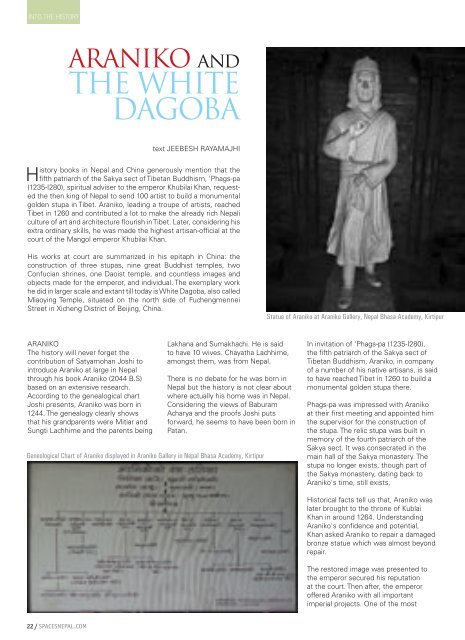9. Sept 2014
Create successful ePaper yourself
Turn your PDF publications into a flip-book with our unique Google optimized e-Paper software.
INTO THE HISTORY<br />
ARANIKO and<br />
THE WHITE<br />
DAGOBA<br />
text JEEBESH RAYAMAJHI<br />
History books in Nepal and China generously mention that the<br />
fifth patriarch of the Sakya sect of Tibetan Buddhism, 'Phags-pa<br />
(1235-I280), spiritual adviser to the emperor Khubilai Khan, requested<br />
the then king of Nepal to send 100 artist to build a monumental<br />
golden stupa in Tibet. Araniko, leading a troupe of artists, reached<br />
Tibet in 1260 and contributed a lot to make the already rich Nepali<br />
culture of art and architecture flourish in Tibet. Later, considering his<br />
extra ordinary skills, he was made the highest artisan-official at the<br />
court of the Mangol emperor Khubilai Khan.<br />
His works at court are summarized in his epitaph in China: the<br />
construction of three stupas, nine great Buddhist temples, two<br />
Confucian shrines, one Daoist temple, and countless images and<br />
objects made for the emperor, and individual. The exemplary work<br />
he did in larger scale and extant till today is White Dagoba, also called<br />
Miaoying Temple, situated on the north side of Fuchengmennei<br />
Street in Xicheng District of Beijing, China.<br />
Statue of Araniko at Araniko Gallery, Nepal Bhasa Academy, Kirtipur<br />
ARANIKO<br />
The history will never forget the<br />
contribution of Satyamohan Joshi to<br />
introduce Araniko at large in Nepal<br />
through his book Araniko (2044 B.S)<br />
based on an extensive research.<br />
According to the genealogical chart<br />
Joshi presents, Araniko was born in<br />
1244. The genealogy clearly shows<br />
that his grandparents were Mitiar and<br />
Sungti Lachhime and the parents being<br />
Lakhana and Sumakhachi. He is said<br />
to have 10 wives. Chayatha Lachhime,<br />
amongst them, was from Nepal.<br />
There is no debate for he was born in<br />
Nepal but the history is not clear about<br />
where actually his home was in Nepal.<br />
Considering the views of Baburam<br />
Acharya and the proofs Joshi puts<br />
forward, he seems to have been born in<br />
Patan.<br />
Geneological Chart of Araniko displayed in Araniko Gallery in Nepal Bhasa Academy, Kirtipur<br />
In invitation of 'Phags-pa (1235-I280),<br />
the fifth patriarch of the Sakya sect of<br />
Tibetan Buddhism, Araniko, in company<br />
of a number of his native artisans, is said<br />
to have reached Tibet in 1260 to build a<br />
monumental golden stupa there.<br />
Phags-pa was impressed with Araniko<br />
at their first meeting and appointed him<br />
the supervisor for the construction of<br />
the stupa. The relic stupa was built in<br />
memory of the fourth patriarch of the<br />
Sakya sect. It was consecrated in the<br />
main hall of the Sakya monastery. The<br />
stupa no longer exists, though part of<br />
the Sakya monastery, dating back to<br />
Araniko's time, still exists.<br />
Historical facts tell us that, Araniko was<br />
later brought to the throne of Kublai<br />
Khan in around 1264. Understanding<br />
Araniko's confidence and potential,<br />
Khan asked Araniko to repair a damaged<br />
bronze statue which was almost beyond<br />
repair.<br />
The restored image was presented to<br />
the emperor secured his reputation<br />
at the court. Then after, the emperor<br />
offered Araniko with all important<br />
imperial projects. One of the most<br />
22 / SPACESNEPAL.COM


















